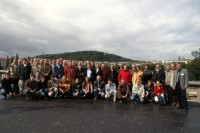 |
 |
|||||||||||||
|
|||||||||||||
|
|||||||||||||
|
The CALICE (Calorimeter for Linear Collider Experiment) collaboration is growing and anticipating the future of ILC calorimeters. The members not only prepare test-beams for the current generation of calorimeter prototypes, but they also prepare the future design of ILC sub-detectors. A record number of 72 CALICE members reviewed and discussed all these aspects two weeks ago in Prague during a collaboration meeting.
One important topic during the meeting was this summer's test-beam at CERN (see 30 August's issue). Participants discussed how they would organise the data and publish the future results when they become available. “It takes time to get the physics out of a test-beam. For the previous test, which occurred in summer 2006, we will probably publish at the end of this year," said Fabrizio Salvatore, one of the two run-coordinators of the test beam and coordinator of the test-beam simulations. “We can already say that preliminary results show that the detectors were really stable for the whole duration of the test.” For Salvatore, it is now crucial to be able to fully simulate the test-beam environment and compare it with the real data. All these test-beam studies will be benchmarks for ILC detectors and will teach the teams how to adjust their detectors for the next generation. From these tests, they aim to understand if a feasible design of a 100-million-channel calorimeter is possible, which is mandatory for optimised hadronic reconstructions. They will also understand the precision of their simulations, especially for the hadronic showers. At the end, the improved prototypes will be very close to ILC final modules. There are already two types of electromagnetic calorimeters (Ecal) and of Hadron calorimeters (HCal). Each of these sub-detectors is funded by regional programmes or agencies, but the results and issues are discussed within the entire collaboration. All these studies will lead to a new generation of calorimeter prototypes. They should be achieved around 2009 and their size will be half of a final ILC module, about 1.5-metre long. The test-beams will then appear like small scale experiments, and CALICE will be able to choose the best technology for Ecal and HCal to include into the ILC Engineering Design Report. So far, the Prague meeting was one of the most important gatherings for the collaboration. Three new groups recently joined: the Max-Planck-Institut für Physik, Germany, and two groups from Morocco. “The CALICE collaboration is growing quickly, and this is a clear indication for us that our work is appreciated outside,” said Jean-Claude Brient, CALICE spokesperson. About 220 people from 45 laboratories now participate. During the meeting, there were no parallel sessions and everyone was invited to react on each topic. “The different sub-detector projects are organised around common working groups and task forces, like for data acquisition system, software, mechanics, test beam analysis, etc.," said Brient. During the test-beam, everyone carefully followed all of the results, even if their specific detector was not tested. “If we want later to compare the different detectors, we need to speak the same language,” said Brient. Collaborators share all the data and discuss issues together. Everyone is involved so that in the end, when the sub-detectors will be selected, nobody loses as a result of the choice. The next step will be the test of nearly all types of calorimeters next summer at Fermilab. The laboratory will provide hadron beams down to about 1 GeV- a low energy which has never been reached before. The energy range of these particles will be very close to the real conditions in the ILC. “We are very impatient to challenge our hadronic shower reconstruction programmes with them,” said Brient. The next CALICE collaboration meeting will take place at Argonne National Laboratory in the US in February 2008. -- Perrine Royole-Degieux
See the meeting slides. |
|||||||||||||
| © International Linear Collider |

